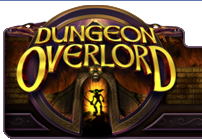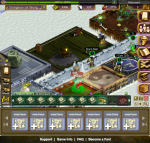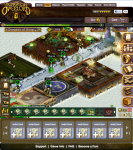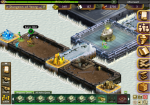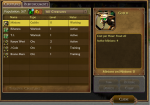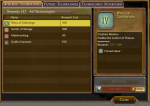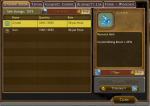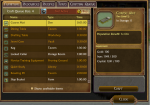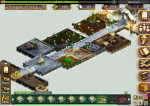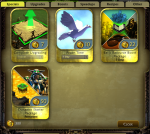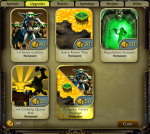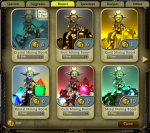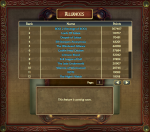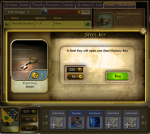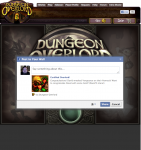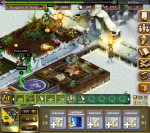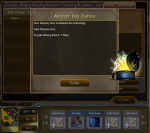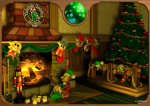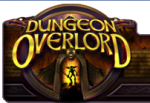Developer/Publisher: Night Owl Games || Overall: 8/10
If you ever thought of opening up your own dungeon in the pits of Hell (or maybe just your local uninhabited doomy-looking mountain overlooking villages to rape and pillage), Dungeon Overlord is your game.
Screw that Farmville crap. It’s time to make some dungeons full of farms! And sleeping areas for the illegals– I mean Goblin workers — and slave chambers for the wise Warlocks writing your scrolls of knowledge to research random things you didn’t think you need to use. I can’t wait until I’m able to spend 20 million research tokens to get mastery over dragons — but I guess I’m getting ahead of myself since that’s about a year out.
So, instead of jumping ahead into the future, let’s start at the beginning. It starts with a very strict tutorial. Strict in the sense that if you don’t follow it, you will royally screw yourself, at least when you are starting to get into the game. It is very strict during that whole phase, despite the fact you can “do other things” while doing the tutorial phase. It can take a lot longer than you may be accustomed to actually “start a game” since you can end up screwing yourself if you are too impatient and look ahead to what quests you can do later on. If you don’t do exactly what the game tells you for the first hours of the game, you essentially can become stuck unless you want to wait a day to get enough resources back to fix your “errors.” You don’t go to the Overworld until you are level 10, which pretty much means the tutorial lasts until then.
Speaking of waiting, that is what most of the game is. Everything happens in real-time and things literally take hours to accomplish. Two hours here, two hours there, things add up. This game was obviously made for people who can log in maybe once or twice a day, so if you’re expecting some sort of traditional game that you can consistently play for more than an hour in one sitting, you’re not getting it. Dungeon Overlord is by no means the only game that propagates this style of gameplay, and if you’re a traditional gamer like I am, it can be sort of annoying having to come back and only being able to do about 5 minutes of playing at any given time. The responsibilities you gain ramp up as you expand, so it feels like there’s more for you to do in any one visit to the game later on.
There are a ton of resources to gain. The list of resources I could find are:
Food, Gold, Research, Experience, Leather, Iron, Crystal, Abyssal Mantle, Adamantite Ore, Deep Ochre, Dense Basalt, Diamond, Feldspar, Heart of the Earth, Mithril Ore, Moonstone, Primordial Earth, Primordial Fire, Primordial Ice, Primordial Water, Quicksilver, Ruby, Shallow Mantle, Adamantite Ingot, Ashen Stone, Cold Iron Ingot, Crystite, Dense Iron Ingot, Goblin Twine, Mana Spark, Mithril Ingot, Reinforced Leather, True Silver Ingot, Prismatic Glass, Whirling Gizmos, Steel Ingot, Explosive Grog, and maybe more?
Why are there so many resources? I don’t know. What basis of the decision is there behind adding more resources? I’m not exactly sure, but each different room requires some of these unique resources to upgrade. Crafted Resources (included in the list) are more complex, because they are made by combining basic resources. It also seems like they can just add more whenever they want, but it’s not like they’d announce that kind of stuff as far as I can see. I don’t even know how I collect half the resources I DO have in my storage spaces right now. I also don’t know what benefit diamonds have over rubies or pig iron other than making cars is better with diamonds. In fact, there are so many resources, it could be kind of confusing trying to figure out why you have them in the first place. I don’t exactly understand how experience is earned other than quests, but I seem to get it anyway, much like other resources I randomly have or get. You get experience just from upgrading your rooms, apparently, even though that isn’t too plainly spelled out for you in-game. I’m about a week or two into the game, and the overall point of gold is to seemingly pay off your servants for the handjobs they give you. You can have as much as you want without any limits to it, and the only way to spend it on any resources you DO need, like Iron or Crystal, is via a hidden menu item in the Overworld where you can buy resources people post for sale. Once you’re able to get to a second dungeon, it increases your resource acquisition by a bit as well.
When you expand to your other dungeons, they work independently of your original one, and you have to ship goods to and from the new dungeon, such as workers, resources, and furniture. It is easy to run out of space in your starter dungeon, so you do need to expand to get more tiles. But of course, you can buy more tiles for your home dungeon!
Games like Dungeon Overlord are free to play, but they thrive on arbitrarily creating quality of life issues, such as waiting three hours for an upgrade, so that you can pay with Facebook Credits to temporarily alleviate any concerns you may have while playing. This game isn’t SO bad in this regard, as you can definitely get by without spending one red cent, but there are many many “opportunities” built into the game to spend your Dungeon Marks (which are the in-game currency converted from Facebook Credits). Using any of these boosts or upgrades gives you a huge advantage over players that do not use the same boosts, and that is probably the point. To me, it seems like the only “useful” upgrades are permanent ones. Paying money for temporary boosts and fast upgrades is not cost effective at all, and you’ll end up spending a lot of money without realizing it, not to mention forgetting to or not being able to fully use the capabilities of those boosts at all times.
The things you actually pay for are things like resource boosts, upgrade completions (at different rates, as well), more tiles to build stuff on, immunity from raids, other stuff like that. You’re not going to find much that is useful below 5 marks, and most of the upgrades and boosts are time-based and temporary, or only apply to the current dungeon you are in, allowing you to purchase those same permanent increases in your other dungeons as well. The current conversion of Facebook Credits is 20 for $1.99. That comes out to about 10 cents per credit, but you get an extra 10-15% extra dungeon marks depending on how much you redeem in-game.
The User Interface is okay, but it can be sort of lacking in regards to trying to figure out how many Dungeon Marks you have — scratch that. While I was playing, they upgraded the game to plainly show how many Dungeon Marks you have, not to mention another handy “buy” button to refill up your marks. As a reviewer playing this game, I got 300 marks to play around with, and I easily spent 105 while being super conservative. Anywho, back to the user interface, the miscellaneous amount of information that you might want to look up are in places you probably wouldn’t intuitively think they should be in, but if you click around enough you eventually do find what you need. There is also a huge “invite friend” toolbar at the bottom that takes up a huge amount of your screen, which I do not like. They might as well make that toolbar an “announce you are an idiot” toolbar, cause I ain’t using it either way.
The Overworld is an interesting place, as each player resides in their own mountain, along with four other players. Each player is able to potentially expand into the rest of the mountain, and if you wanted to, attack your neighbor’s dungeons as well. There is quite a lot of real estate available in each mountain, and depending on how active your neighbors are, you might even have the whole thing to yourself. Raiding is just another way to gain resources, and can only be done in the Overworld screen. The raids on other dungeons and towns are passive (meaning all you need to do is wait for it to happen and then it does), and they usually require a certain amount of minions. You use orcs to raid, initially, and eventually use other units such as Thieves, Warlocks, Dark Elves, etc etc etc. Once a battle is over, you can “watch” the battle as it happened, but it is basically just your minions going in and moving very slowly until they find something to whack and then I guess the goal of your minions is to get to the vault, steal gold and other resources, and then leave. There is no destruction of any rooms or anything like that. Raiding is useful because some resources are only gained by raiding, such as leather. The world map actually has many different zones and other villages around your mountain.
For some reason, the keyboard does not work when you are in full screen mode. Don’t ask me why, but that’s annoying when you’re trying to rename something into your favorite rapper. When you start out the game, annoying “share” pop-ups appear every other quest, which takes you out of the game so you can tell your friends how much fun you’re having placing a jewel box in your vault. It tapers off after the Tutorial quests complete, but occasionally you still see them. I can understand that they want you to share with your friends, but it really breaks up the experience by tossing you out of the game (especially if you’re in full screen mode) to do so. It should be integrated into the game, if anything. In fact, the invite friend bar should be used for this purpose. I’d actually prefer that this didn’t happen at all, but thems the bricks, I suppose. The constant badgering of telling you to share stuff with your friends is almost a game breaker for me, and I probably would have stopped playing if it weren’t for the fact that I was going to write something about it.
There is a lot of noise pollution created by this game. Sound effects are constantly going, and doesn’t seem to have had much design intent involved as to when you hear most of the sounds going on. They are just on an endless loop. There is music, which you can mute independently. You can also mute everything, but there is no way to mute ONLY sound effects if you felt like you wanted to listen to the music in the game. I guess I should be thankful that the game remembers you keep the sound on mute.
The graphics in the game are reminiscent of Roller Coaster Tycoon, a game about ten years old. It’s not exactly something I missed, but I guess its nice to see that quality of art again in a new game. It has a sense of humor, which is nice, as well, but that’s only if you care to read anything the quests say, and some of the nuances in the things your decorations do on your rooms. The game can “improve” or “change” at any time, as well. Earlier when I was playing the game, I was going to make note of terrible use of screen real estate with the friend invite bar that is so usefully (/sarcasm) placed at the bottom of the screen at all times, and not knowing how many Dungeon Marks you actually have, but it was updated literally the next day and alleviated that “issue.” But that doesn’t mean that every version change is a good thing. The new version I had been playing made me freeze on the loading screens between different areas, resulting in it taking for-fucking-ever. When stuff like that happens, I guess you just have to wait until they fix it since they can potentially update it at any time without letting you know. In this case, the freezing issue was fixed by the next day.
Gameplay issues come mostly in the form of the intentional gating to artificially inflate the time one can spend on the game. For instance, you can only upgrade one thing at a time. Though, this provides a challenge in and of itself in the form of using time as a resource — what should you waste more time on to upgrade first and what will be more useful. It is easy to run out of tiles to build rooms on, and there is a hard cap for each dungeon — you just have to pay for the last 50. Research costs will grow exponentially, meaning you will have less and less times where you’re going to actually have enough research to get new features in the game. It would also be more convenient to be able to “request” supplies from your main dungeon rather than having to go your main dungeon and move supplies to your expansion dungeons each time you need something.
There is no “end” to this game, and that is good and bad thing. Good, because well, you can keep playing until you don’t want to, and bad because of how much money you might actually sink into the game. It is so easy to spend Dungeon Marks on temporary benefits, that it is quite scary. I also see the boasting of the game being a “massively multiplayer” game as a buzz word to get drawn in to initially playing. It is simply multiplayer with many people having persistent locations for their dungeons. There isn’t much of a way to tell if these other players are actually playing consistently or as much as you, other than checking out what level they are.
Whether or not the game is fun, I guess you could say it is. There is some sort of satisfaction in seeing your progress and upgrading of your dungeons as time goes on, and acquiring a massive amount of resources also has some weird pleasure factor involved, even if I don’t understand the intricacies of every single mechanic. If you like this sort of drop-in-a-bucket gameplay that Dungeon Overlord has to offer, then you should give it a try.
If you have a Facebook account, you can check it out here.

